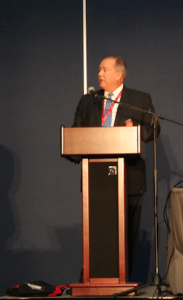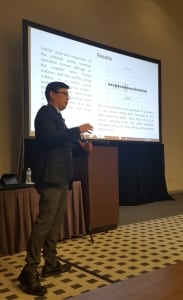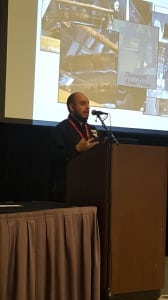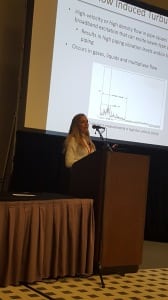
Jody Elliott of Oxy Oil & Gas welcomes attendees to the 2017 Turbomachinery and Pump Symposia on December 12
Following an introduction from outgoing Turbomachinery Lab director Dara Childs, Jody Elliott, president of domestic oil and gas at Oxy Oil & Gas kicked off the 2017 Turbomachinery and Pump Symposia (TPS) on Tuesday with a welcome address focused on the importance of compression technologies in enhanced oil recovery (EOR) activities. “The use of compression makes EOR happen,” said Elliott. He placed special emphasis on the critical role of advanced maintenance technologies and data analytics in ensuring optimal performance from compressors. Elliott broke down Oxy’s installed compressor base as 30% centrifugal compressors, 60% reciprocating compressors and 10% flooded screw compressors, all of which experience a wide variety of service conditions. EOR is a closed-loop process that involves the injection of large volumes of CO2 to extract additional reserves from existing wells. CO2 mixes with and releases oil from formation, freeing it to move into producing wells. CO2 is then separated and re-injected or recycled. Oxy currently has 34 active CO2 floods in EOR operation. Currently, the U.S. gets about 5% of its total domestic oil production from CO2-based EOR processes, according to Elliott.
“Maintenance is critical for us to be competitive in EOR,” said Elliott. He reported that Oxy’s Permian Basin EOR operations must manage 20,000 maintenance activities per month. He listed several critical maintenance technologies used for Oxy’s EOR gas-plant compressors, including advanced infrared-imaging cameras to detect hot spots on equipment and gas-imaging cameras to detect gases that are invisible to the naked eye. This helps keep areas safe from combustible gases like H2S, and also minimizes gas loss due to leakage. The company uses machinery analyzers to diagnose problems and determine if a shutdown or other preventive action is required. This device monitors pressure, vibration, ultrasound, temperature and spark voltage to analyze the mechanical condition of compressors and other devices. Ultrasonic probes with headphones also contribute to the detection of both external and internal leaks from compressors. “None of what we do in EOR would be possible without this machinery,” said Elliott. “Much like a doctor evaluating a patient, our maintenance programs allow us to know the health of each compressor through routine checks,” he continued.
Elliott also outlined Oxy’s platform to encourage company-wide innovation and the role data analytics plays in moving new ideas forward. “Analytics not only accelerates learning in many cases, but it can transform work processes and create step-change improvements in your performance,” he said. He also reiterated the importance of seeking input from other industries. Oxy partners with universities and service companies to monitor relevant techniques and practices that have been shown to add value in other industries. He closed the address by encouraging attendees to reach out to all industries to gain ideas and inspiration about what has worked in diverse sectors.

Maki Onari presents case studies on the benefits of using accelerometers for pump cavitation evaluation
Data analysis also took center stage in two technical lectures Tuesday morning at TPS. In one lecture, William Marscher and Maki Onari from Mechanical Solutions Inc. (www.mechsol.com) presented on the use of accelerometers to evaluate pump cavitation severity. They compared the benefits of accelerometers to traditional cavitation-analysis techniques, including dynamic pressure transducers. Commonly used frequency-based qualitative methods for cavitation analysis may require a “before and after” comparison, explained Marscher, meaning that the frequency spectrum data are only very useful if the same data are available for the pump during normal (non-cavitating) operations. Instead of looking at cavitation on a frequency basis, accelerometers enable cavitation to be evaluated based on time, which provides data that allow for discrimination between cavitation and other pump behaviors. The presenters discussed three case studies, all from water-treatment plants in the U.S., where accelerometer data were analyzed to develop recommendations to diagnose and, in some cases, mitigate pump cavitation issues. While the presenters reiterated that there is still much research and pilot testing to be done on the application of accelerometer devices in cavitation analysis, their work concluded that it is an effective “quasi-quantitative” technique to assess the degree of damage being caused by pump cavitation.
Sarah Simons and Francisco Fierro of the Southwest Research Institute (www.swri.org) led a lecture on analyzing transient events (such as slugging, waterhammer and cavitation) in pump piping systems. The methodology they presented emphasized that the most complete solution for analyzing complex flow phenomena is to combine several analysis tools, including finite element analysis, stress analysis, evaluation of flow-induced excitations and multiphase modeling. The combination of acoustic, mechanical and hydraulic analysis creates a toolkit that enables the team to provide guidance to operators when a transient event arises. The presenters outlined a case study where an operator reported a transient pressure wave in a water line. SRI’s analysis traced the issues to a rupture disc on a heat exchanger and they expanded their model to include more heat exchangers and additional pressure-relief scenarios, as well as a sensitivity analysis around burst pressures. Their work highlighted some loose piping supports in the facility, which were tightened to help stabilize the piping. The analysis also led to a recommendation to install a check valve in the system.

